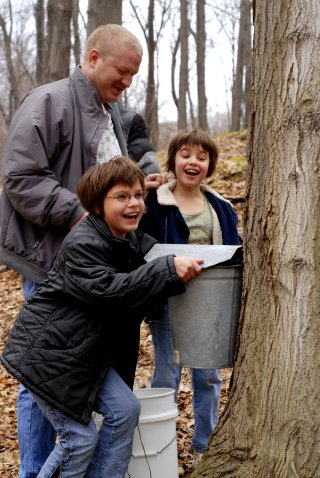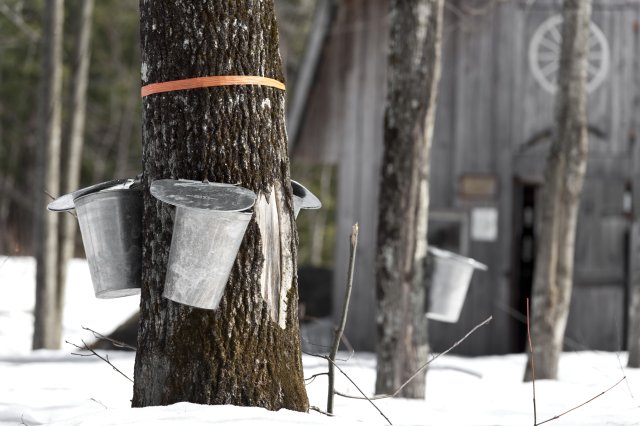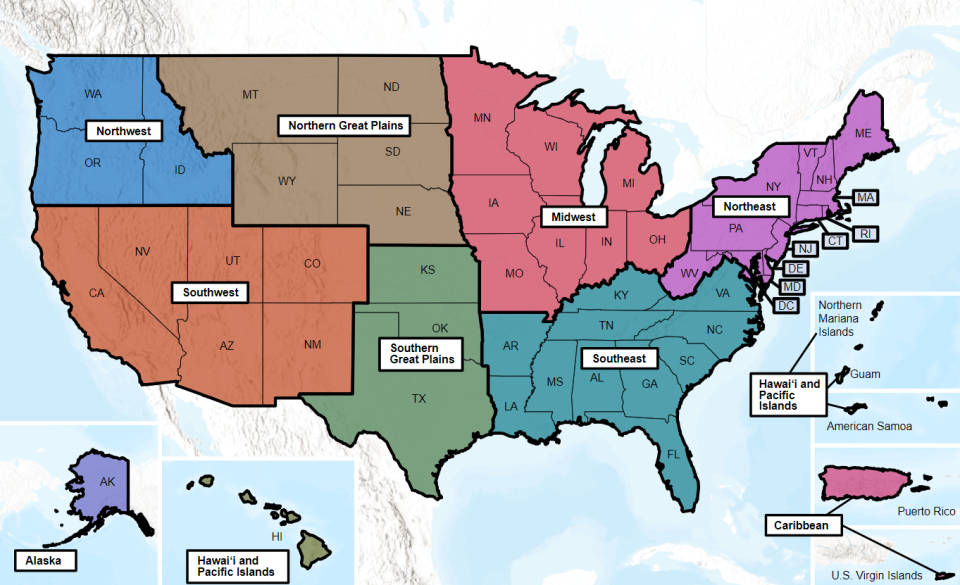Climate Change Connections: Vermont (Maple Syrup)
Climate change is impacting all regions and sectors of the United States. The State and Regional Climate Change Connections resource highlights climate change connections to culturally, ecologically, or economically important features of each state and territory. The content on this page provides an illustrative example. As climate change will affect each state and territory in diverse ways, this resource only describes a small portion of these risks. For more comprehensive information about regional climate impacts, please visit the Fifth National Climate Assessment and Climate Change Impacts by Sector.
On this page:
Introduction: Maple Syrup—A Sweet Tradition in Vermont
Vermont is the top producer of maple syrup in the country, which made maple a natural choice to be Vermont’s official flavor and the sugar maple (Acer saccharum) to be the state tree.1–4 Maple syrup and other maple products are economically and culturally important to Vermont. Since 1916, Vermont has boasted more maple taps per year than any other state; in 2023, it had over 6 million taps, producing over 2 million gallons of syrup.3,5

In addition to the millions of dollars of direct value from syrup sales,5 tourism driven by maple syrup also contributes to the local economy. Each year, Vermonters and visitors can take part in many events celebrating all things maple. The Vermont Maple Festival, held every April, celebrates the maple syrup harvest with events like sugarhouse tours, demonstrations, crafts, and a pancake breakfast. In September and October, the Vermont Agency of Agriculture, Food, and Markets supports the Maple 100, a month of maple-themed activities.
Maple products hold cultural significance to many Indigenous People, who made maple syrup and sugar long before European settlers came to North America.6 Sugar maple has long been an important staple food source and a part of cultural traditions, and numerous Tribes’ oral histories include stories about the origin of maple sugaring.6–8 Today, the maple industry continues to provide income for local farms and Indigenous communities.9
Climate Impacts: Warming Temperatures Impact Sap Production
Climate change is bringing warmer temperatures and seasonal changes that are expected to affect the timing and duration of sap flow, the sugar content of sap, and forest health.10,11 Sap flow depends on several factors, including temperature fluctuations—specifically, freeze-thaw events, which occur when temperatures fall below freezing, then rise enough for thawing.12 Climate change is impacting freeze-thaw conditions across the contiguous 48 states, and the number of unfrozen days has increased at an average of about four days per decade since the 1970s.13 In Vermont, later first fall freezes and earlier last spring freezes have been observed, and since 2005, the freeze-free season has extended by nearly a week compared with the average length during the 1970–2004 period.14
When temperatures dip below freezing (typically at night) and then rise above freezing, the pressure difference created within the tree causes sap to flow.12 The sap flow season usually lasts four to six weeks, ending when temperatures remain consistently above freezing and buds are no longer dormant.12 Changing average temperatures during the tapping season, which typically runs from January to May, are projected to further influence freeze-thaw cycles, affecting the number of sap collection days and the total amount of sap collected over the next century.9 Warming temperatures could also shift the geographic range with ideal climate conditions for maple syrup production.9,15 By 2100, some projections estimate that the region of maximum sap flow could shift north by nearly 250 miles.9

Climate change can also affect maple syrup production and quality by influencing the ratio of sugar to water in the trees’ sap.9 The sugar in maple sap comes from carbohydrate stores, which are affected by the previous years’ growing conditions. Warmer average temperatures in the previous year’s growing season are linked to lower sugar concentrations in the next year’s sap.9 One study projects that maple sap’s sugar content will decline by about one-third by 2100 across the sugar maple’s range.9
In addition to the impacts on syrup production, maple tree forests face additional challenges in a changing climate. Warmer temperatures can shorten sap season by encouraging early bud break and promoting microorganism growth, which can clog tap holes.9,16 Warming winter temperatures are also expected to result in less snowpack, making the exposed soil more likely to freeze.17,18 Frozen soil can harm the trees’ fine roots, and increased soil frost has been shown to negatively affect sugar maple growth.9,15
Taking Action: Protecting Syrup Production in a Changing Climate
Addressing climate change requires reducing greenhouse gas emissions while preparing for and protecting against current and future climate impacts. Communities, public officials, and individuals in every part of the United States can continue to explore and implement climate adaptation and mitigation measures. In Vermont, many forest managers and maple syrup producers have begun preparing for syruping in a changing climate, including by:
- Diversifying species. Researchers and producers are collaborating to identify different species that can be tapped to make syrup.12,19 While most syrup is sourced from sugar maple, there is a growing interest in expanding syrup production from additional maple, walnut, birch, and beech trees.19 Increasing species diversity can also help make forests more resilient to pests, diseases, and other stressors.
- Using technology. Some maple syrup producers are leveraging new practices and technologies to make harvesting and processing more efficient.20 Technology like evaporators, reverse osmosis (high-pressure separation of sap and water), and vacuum pumps can improve harvesting efficiency. Initial investment in technology may be costly for some smaller producers.
To learn more about climate change impacts in Vermont and the Northeast region, see Chapter 21 of the Fifth National Climate Assessment.
Related Resources
- EPA Climate Change Indicators: Freeze-Thaw Conditions
- EPA Climate Change Indicators: Seasonal Temperatures
- Vermont State Climate Summary 2022 (NOAA)
- Maple Syrup (USDA Climate Hubs)
- Maple Syrup Industry Adapting to Climate Change (USGS)
References
1 Vermont Agency of Natural Resources. (n.d.). Overview of Vermont’s forests. Department of Forests, Parks and Recreation. Retrieved January 11, 2024, from https://fpr.vermont.gov/forest/vermonts-forests
2 510. State Flavor, 139, 1 V.S.A. (1994). https://legislature.vermont.gov/statutes/section/01/011/00510
3 U.S. Department of Agriculture. (2023). Maple syrup production down 20% from historic production in Vermont. https://www.nass.usda.gov/Statistics_by_State/New_England_includes/Publications/Current_News_Release/2023/Vermont-2023-Maple-Production.pdf
4 U.S. Department of Agriculture. (2022). Record high maple syrup production in Vermont. https://www.nass.usda.gov/Statistics_by_State/New_England_includes/Publications/Current_News_Release/2022/Vermont_2022_Maple_Production.pdf
5 U.S. Department of Agriculture National Agricultural Statistics Service. (2023). Crop production (June 2023). U.S. Department of Agriculture. https://downloads.usda.library.cornell.edu/usda-esmis/files/tm70mv177/9306vd43x/79409d319/crop0623.pdf
6 Chamberlain, J. (2020). NTFPs from trees: sugar maple. (Science Update SU-SRS-140). U.S. Department of Agriculture Forest Service, Southern Research Station. https://doi.org/10.2737/SRS-SU-140
7 University of Vermont Libraries & AgNIC. (2022). History of maple. Maple Research Guides. Retrieved January 11, 2024, from https://researchguides.uvm.edu/c.php?g=290518&p=1936100
8 Seiler, L. (2008). The History of Maple Sugaring. Natureʼs Grapevine. https://nj.gov/dep/parksandforests/parks/images/winter_08.pdf
9 Rapp, J. M., Lutz, D. A., Huish, R. D., Dufour, B., Ahmed, S., Morelli, T. L., & Stinson, K. A. (2019). Finding the sweet spot: Shifting optimal climate for maple syrup production in North America. Forest Ecology and Management, 448, 187–197. https://doi.org/10.1016/j.foreco.2019.05.045
10 Matthews, S. N., & Iverson, L. R. (2017). Managing for delicious ecosystem service under climate change: Can United States sugar maple (Acer saccharum) syrup production be maintained in a warming climate? International Journal of Biodiversity Science, Ecosystem Services & Management, 13(2), 40–52. https://doi.org/10.1080/21513732.2017.1285815
11 Wilson, A. B., Baker, J. M., Ainsworth, E. A., Andresen, J., Austin, J. A., Dukes, J. S., Gibbons, E., Hoppe, B. O., LeDee, O. E., Noel, J., Roop, H. A., Smith, S. A., Todey, D. P., Wolf, R., & Wood, J. D. (2023). Ch. 24. Midwest. In A. R. Crimmins, C. W. Avery, D. R. Easterling, K. E. Kunkel, B. C. Stewart, & T. K. Maycock (Eds.), Fifth National Climate Assessment. U.S. Global Change Research Program. https://doi.org/10.7930/NCA5.2023.CH24
12 Giesting, K. (2020). Maple syrup. USDA Climate Change Resource Center. Retrieved January 11, 2024, from https://www.climatehubs.usda.gov/sites/default/files/Maple-Syrup_CCRC.pdf
13 EPA. (2023). Climate change indicators: Freeze-thaw conditions. Retrieved January 11, 2024, from https://www.epa.gov/climate-indicators/climate-change-indicators-freeze-thaw-conditions
14 Runkle, J., Kunkel, K. E., Champion, S. M., Dupigny-Giroux, L.-A., & Spaccio, J. (2022). Vermont state climate summary 2022 (NOAA Technical Report NESDIS 150-VT). NOAA National Environmental Satellite, Data, and Information Service. https://statesummaries.ncics.org/chapter/vt/
15 Oswald, E. M., Pontius, J., Rayback, S. A., Schaberg, P. G., Wilmot, S. H., & Dupigny-Giroux, L.-A. (2018). The complex relationship between climate and sugar maple health: Climate change implications in Vermont for a key northern hardwood species. Forest Ecology and Management, 422, 303–312. https://doi.org/10.1016/j.foreco.2018.04.014
16 EPA. (2023). Climate change indicators: Length of growing season. Retrieved January 11, 2024, from https://www.epa.gov/climate-indicators/climate-change-indicators-length-growing-season
17 Reinmann, A. B., Susser, J. R., Demaria, E. M. C., & Templer, P. H. (2019). Declines in northern forest tree growth following snowpack decline and soil freezing. Global Change Biology, 25(2), 420–430. https://doi.org/10.1111/gcb.14420
18 EPA. (2022). Climate change indicators: Seasonal temperature. Climate Change Indicators. Retrieved June 11, 2024, from https://www.epa.gov/climate-indicators/climate-change-indicators-seasonal-temperature
19 U.S. Geological Survey. (n.d.). Maple syrup industry adapting to climate change. Climate Adaptation Science Centers. Retrieved January 12, 2024, from https://www.usgs.gov/programs/climate-adaptation-science-centers/maple-syrup-industry-adapting-climate-change
20 Ahmed, S., Lutz, D., Rapp, J., Huish, R., Dufour, B., Brunelle, A., Morelli, T. L., Stinson, K., & Warne, T. (2023). Climate change and maple syrup: Producer observations, perceptions, knowledge, and adaptation strategies. Frontiers in Forests and Global Change, 6, 1092218. https://doi.org/10.3389/ffgc.2023.1092218

